- What is hyperspectral imaging?
- Remote sensing spacecraft with hyperspectral imaging capability
- Difference between hyperspectral and multispectral imaging
- Differences between hyperspectral (HS) and shortwave infrared (SWIR) images
- Hyperspectral imagery from UAV and airplane
- Applications of hyperspectral imaging
What is Hyperspectral Imaging?
Hyperspectral imaging is a technology for collecting and analyzing data based on measuring electromagnetic radiation in numerous narrow spectral bands spanning the entire visible and infrared spectrum (sometimes including the ultraviolet spectrum). In contrast to conventional imaging, which records information in only a few broad bands (e.g., red, green, and blue channels), hyperspectral imaging separates electromagnetic radiation into hundreds or even thousands of narrow spectral bands.
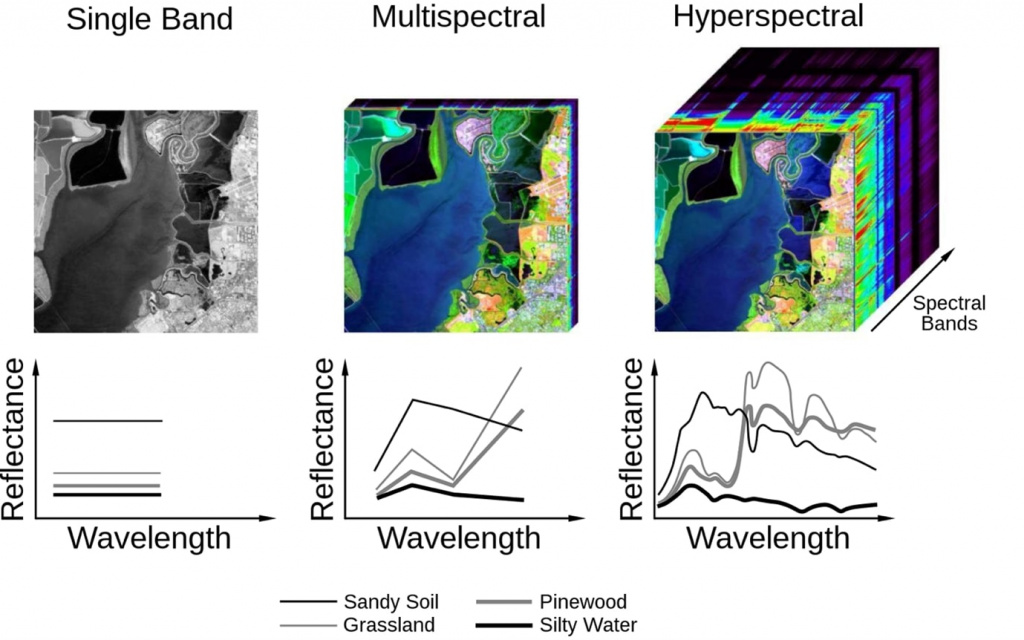
The electromagnetic spectrum describes all types of light: from very long radio waves, microwaves, infrared radiation, visible light, ultraviolet rays, and X-rays to very short gamma rays, most of which the human eye cannot see (Figure 1).
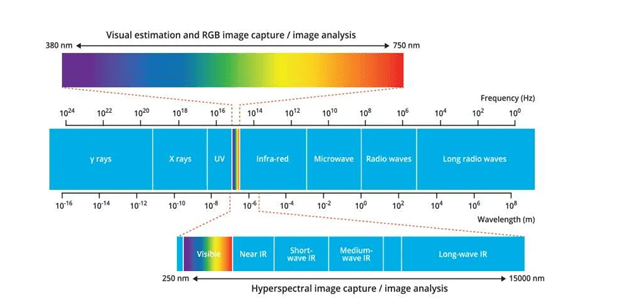
Hyperspectral images have high spectral but low spatial resolution, whereas multispectral images have high spatial but low spectral resolution. Research on combining data has shown that merging multi- and hyperspectral data allows more accurate classification of objects.
Hyperspectral sensors collect data as a set of images, each image in the set representing a narrow range of wavelengths of the electromagnetic spectrum, also known as the spectral range. These images are combined to form a three-dimensional hyperspectral data cube for processing and analysis. The hyperspectral cube contains spectral data along one dimension and spatial data along the other two, which can be used to create a detailed pixel-wise chemical and spatial map.
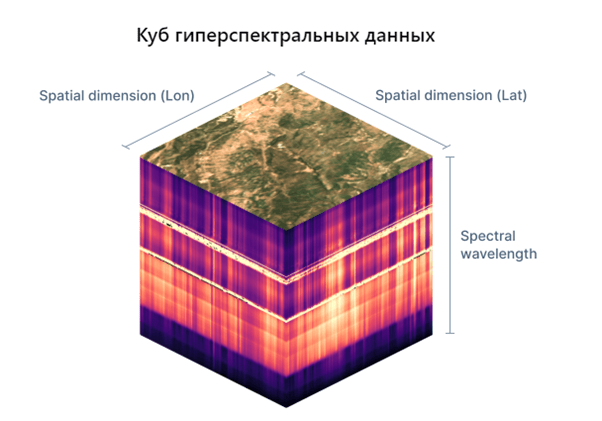
The spatial and spectral characteristics of the obtained hyperspectral data are characterized by information embedded in its pixels. Each pixel is a vector of values that determine intensities at a specific location (x, y spatial coordinates) in z different ranges. This vector is known as the pixel spectrum, and it defines the spectral signature of the pixel at (x, y), i.e., the data stored in the pixel provides information about its spectrum across the entire range of the sensor used. Pixel spectra are important features when analyzing hyperspectral data. However, these pixel spectra are distorted due to various factors (sensor noise, atmospheric effects, low resolution, etc.).

Satellite images obtained using hyperspectral sensors are not as widely available as multispectral ones, due to the limited number of spacecraft equipped with corresponding sensors and the cost of the acquired images. As of December 2023, there is a significant increase in announced projects for launching spacecraft with hyperspectral imaging capabilities.
Advantages of hyperspectral data:
- More spectral bands.
- Better object discrimination ability.
- More accurate analysis of chemical composition.
- Wider range of applications.
Despite its advantages, hyperspectral data also has several drawbacks:
- High computational power requirements.
- Expensive equipment.
- Limited spatial resolution of images.
- Expertise required for data interpretation.
Currently, there are several software suites designed for processing aerospace images, including hyperspectral data, developed by various organizations, the main ones being:
- ENVI (EXELIS);
- ERDAS ErMapper, ERDAS Imaging (Intergraph, ERDAS);
- GEOMATICA (PCI Geomatics);
- Aspect-Stat, Shell, Multiclass, Dinklass (NII "Aerocosmos"),
- and others.
Spacecraft with Hyperspectral Imaging Capability
Hyperspectral equipment is most commonly found on specialized satellite platforms with wide imaging capabilities.
Satellites capable of collecting hyperspectral data:
HJ-1A&1B Satellite
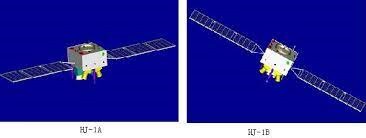
Launched on 06.12.2008, the Chinese HJ-1A&1B satellite consists of two optical hyperspectral satellites, HJ-1A and HJ-1B, and one radar satellite.
HJ-1A is equipped with one CCD camera and one hyperspectral recorder, while HJ-1B has one CCD camera and one infrared camera. Both CCD cameras follow the same design principle, symmetrically positioned nadir and parallel, covering a 700 km swath with a spatial resolution of 30 m in four spectral channels.
The hyperspectral recorder allows Earth imaging in a 50 km swath, with a spatial resolution of 100 m, 110–128 channels, and a viewing angle range of 30 degrees.
The infrared scanner covers a 720 km swath with resolutions of 150/300 m in four spectral channels.
GHOSt Satellite (Global Hyperspectral Observation Satellite)
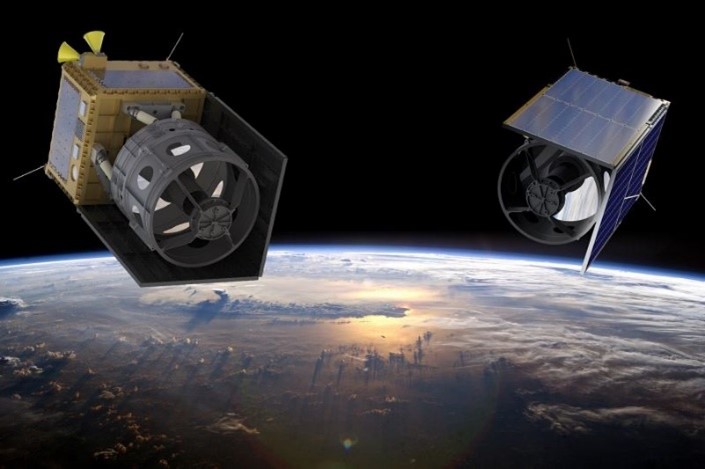
The first GHOSt satellites were launched on 15.04.2023, representing a group of six technically identical microsatellites for hyperspectral imaging by the American company Orbital Sidekick Inc. Each GHOSt satellite is equipped with a patented hyperspectral imager produced by OSK. The sensor captures 512 spectral ranges from visible (VIS) to shortwave infrared (SWIR).
Hyperspectral sensors on board the group provide a spatial resolution of 8.3 m for the multispectral range and 3 m for the panchromatic range.
As of December 2023, three satellites out of the planned six have been launched.
OHS Satellite
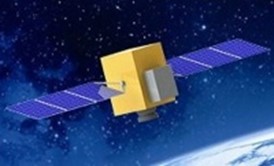
Ten new hyperspectral satellites by Orbita Aerospace were launched in 2019. The OHS satellite stands out with relatively high spatial resolution, allowing for up to 256 channels.
Spatial resolution: 10 m
Swath width: 150 km-500 km
Spectral channels: 256 (optional 32)
Spectral resolution: 2.5 nm
Imaging range: 150 km × 2500 km
Spectral range: 400-1000 nm
Resurs-P Satellite
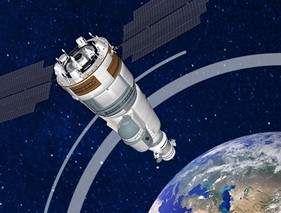
Resurs-P (Perspective) is a Russian Earth remote sensing satellite created by the Federal State Unitary Enterprise Space Research and Production Center "Progress" to replace the Resurs-DK1 satellite.
The satellite, equipped with the "GEOTON-L1" instrument, provides high-detail Earth imaging with a resolution of 70 centimeters in monochromatic mode. The swath width captured in one pass is 38 km.
The hyperspectral observation complex (HOC) captures in 96—255 channels (wavelength 0.4—1.1 µm) with a resolution of 25—30 m in a 25 km swath.
EO-1 Satellite
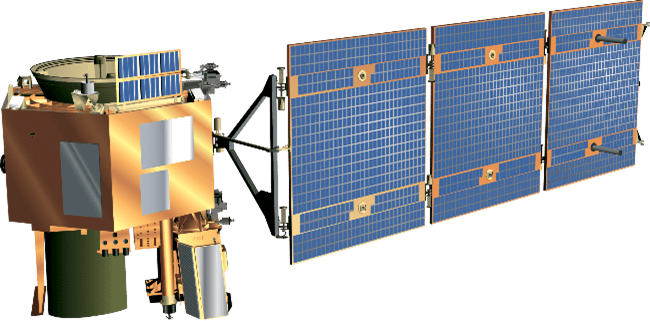
The Earth Observing-1 (EO-1) satellite was launched on 21.11.2000. Hyperion, a grating spectrometer on board EO-1, has a 30-meter ground resolution, covering a 7.7 km swath. It captures in the spectral range of 400–2500 nm with a 10 nm interval for each of its 220 channels.
Retired from operation on 30.03.2017.
HyspIRI Mission
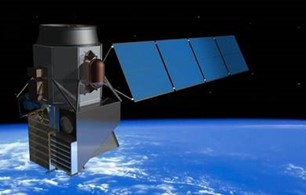
The Hyperspectral Infrared Imager (HyspIRI) mission includes two instruments on a satellite in low Earth orbit. It has a visualizing spectrometer measuring from the visible to shortwave infrared range (VSWIR: 380–2500 nm) in adjacent ranges of 10 nm each, and a multispectral imager measuring from 3 to 12 µm in the mid and thermal infrared range (TIR). Both VSWIR and TIR instruments have a spatial resolution of 60 m nadir. The revisit time for VSWIR is 19 days, and for TIR, it is 5 days. HyspIRI also includes an Intelligent Payload Module (IPM) that provides direct transmission of a subset of data.
KA PROBA-1
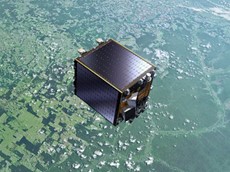
PROBA-1 is a Belgian satellite launched on 22.10.2001 with CHRIS and HRC equipment onboard. CHRIS is a hyperspectral system (200 narrow channels) that allows capturing images with a resolution of 17 m, and HRC is a monochromatic camera that captures visible light with a resolution of 5 m.
The second satellite in the PROBA-1 series, PROBA-1, was launched on 02.11.2009 along with the SMOS satellite.
PRISMA

PRISMA, launched on 22.03.2019, is a medium-resolution hyperspectral imaging satellite developed, owned, and operated by ASI (Agenzia Spaziale Italiana). The mission, intended to last for 5 years, is the successor to the discontinued HypSEO mission (Hyperspectral Satellite for Earth Observation).
The HYC module has a spatial resolution of 30 m and operates in two ranges: a 66-channel VIS/NIR range with a spectral interval of 400–1010 nm and a 171-channel NIR/SWIR range with a spectral interval of 920–2505 nm. It uses a 30 km swath scanning method.
EnMAP
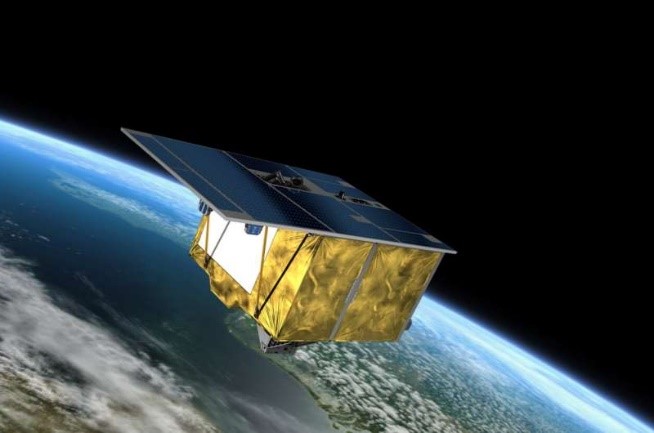
Environmental Mapping and Analysis Program (EnMAP) is a German satellite mission aimed at obtaining hyperspectral image data of the Earth's atmosphere and surface. Launched in 04.2022, the mission is operated by the German Aerospace Center (DLR).
HSI functions as an image scanner, observing in the spectral range of 430–2450 nm and providing global coverage. EnMAP samples 228 spectral bands with intervals of 6.5 nm and 10 nm in the VNIR and SWIR channels, respectively. The spatial resolution on the ground is 30 m, and the maximum swath width is 30 km.
CartoSat 3, 3A, 3B
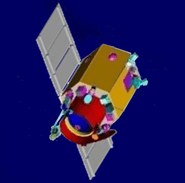
CartoSat 3, 3A, 3B – a series of high-resolution satellites complementing India's optical-electronic reconnaissance satellite system and dual-use Earth observation satellite system.
Cartosat 3 is designed as a continuation of the Cartosat 2 Earth observation satellite series. The new satellites have improved spatial characteristics.
The useful payload aboard the CartoSat 3 series includes:
- High-resolution optical-electronic equipment operating in panchromatic mode with a ground resolution of 0.25 m in a 16 km strip;
- Multispectral camera with a spatial resolution of 1 m in a 16 km strip, 3 VIS channels, 1 NIR channel;
- Hyperspectral camera with a spatial resolution of 12 m and a 5 km swath width, having 200 channels in SWIR;
Pixxel

Pixxel is an Indian startup developing a constellation of hyperspectral imaging satellites for applications in agriculture, government, environment, energy, and mining. The first two satellites of the constellation, TD-2 and TD-1, were launched on 01.04.2022 and 26.11.2022.
The hyperspectral image scanner on board TD-1 and 2 transmits 150 spectral ranges with a spatial resolution of 10 m. A thermal imager, planned for the rest of the satellite constellation, will carry 300 spectral ranges with a spatial resolution of 5 meters. Pixxel plans to launch a constellation of 24 commercial hyperspectral imaging satellites by 2024–2025, providing a 24-hour revisit period for obtaining rapid satellite images.
Dragonette (EPICHyper 1, 2, 3)
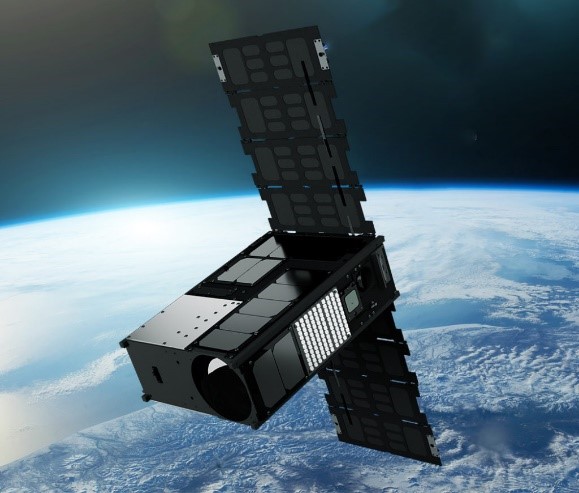
Dragonette-001 (EPICHyper 1, 2, 3) by the Canadian company Wyvern was launched on 04.2023, 06.2023, and 11.2023. With a spectral range from 500 to 800 nm and high daily throughput, this satellite will be ready to collect commercial hyperspectral data in early 2024.
ZY Hyperspectral (ZY1-02D)
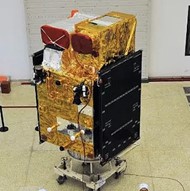
ZY-1 02D is China's first civil operational hyperspectral (HS) satellite, independently developed and successfully launched in 2019. It is jointly operated by the Brazilian Institute of Space Research and the China Center for Earth Operation and Digital Earth (CEODE).
Number of spectral channels – 166
Spatial resolution, m – 2.5, 10, 30
Swath width, km – 60
Capture period, days – 3
GaoFen
GaoFen 5 was launched on 08.05.2018. It is China's first hyperspectral imaging satellite. The second one, Gaofen 5–02, was launched in 09.2021. It is designed for detecting changes in global land and water resources, monitoring air pollution, and greenhouse gases in the atmosphere.
Number of channels – 330
Spectral range, nm – 0.39~2.513
Spectral resolution, nm 4 (VNIR); 8 (SWIR)
Spatial resolution, m – 30
Swath width, km – 60
PACEPACE
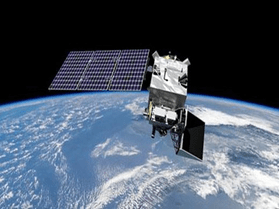
PACEPACE (Plankton, Aerosol, Cloud, Ecosystem Ocean) is a NASA mission scheduled for launch in 01.2024.
PACE will be in a sun-synchronous orbit at an altitude of 677 km. OCI will have a maximum swath width of 2500 kilometers, a resolution of 1 km, and a spectral resolution of 5 nm. It will be capable of measuring wavelengths from ultraviolet (340 nm) to near-infrared (890 nm).
The swath width is 100 km, resolution is 2.5 km, measurements are taken in the wavelength range of 385–770 nm with a 2 nm interval. Its goal is to provide polarimetric accuracy of 0.3% and radiometric accuracy of 2%.
Difference Between Hyperspectral and Multispectral Imaging
Multispectral imaging typically uses three bands of visible light (red, green, and blue) and one or more infrared channels to create images. In contrast, hyperspectral images allow the exploration of how objects interact across a much larger range of wavelengths, from 250 nm to 15,000 nm, including the thermal infrared range.
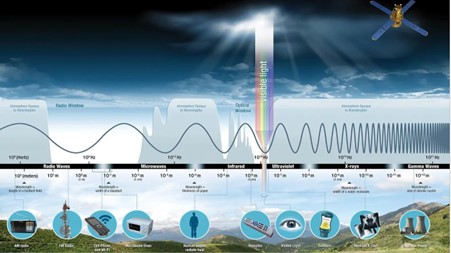
The main difference between multispectral and hyperspectral imaging lies in the number of bands and their width. Hyperspectral images typically include hundreds of spectral bands with a relatively narrow bandwidth (around 5–10 nm), while multispectral datasets consist of approximately 3–15 bands (sometimes more) with a broader bandwidth (70–400 nm). There is no clear boundary between multispectral and hyperspectral Earth observation satellites in terms of the number of spectral channels or the width of the spectral bands. In some sources, multispectral satellites may have a maximum of 4 channels, while in others, they may have up to 15. Narrow spectral channels can detect subtle spectral features that might go unnoticed in broader ranges of multispectral scanning systems, allowing for smoother spectral curves over a wider range instead of jagged lines with peaks at spectrum transition points.
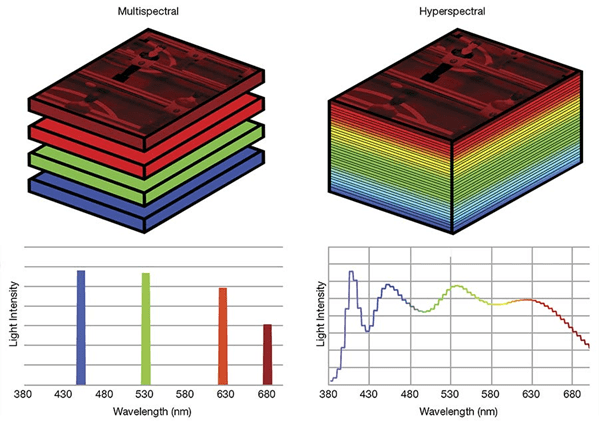
Hyperspectral images can have hundreds or thousands of bands. Typically, these bands do not have descriptive names.
Hyperspectral imaging allows us to distinguish materials with similar physical or visual characteristics or those invisible to the human eye, such as various minerals. Hyperspectral data provides a much broader spectrum of information and more accurate spectral profiles for analysis.
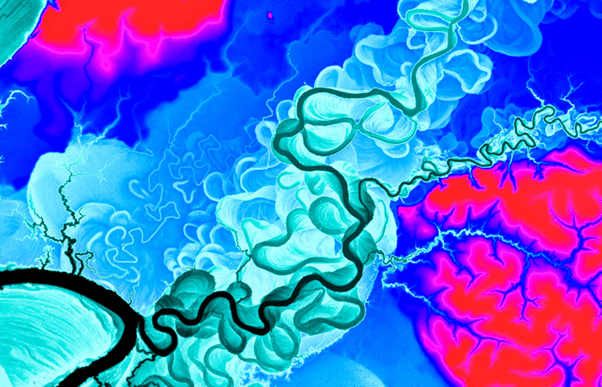
Differences Between Hyperspectral (HS) and Short-Wave Infrared (SWIR) Imagery
The differences between hyperspectral (HS) and Short-Wave Infrared (SWIR) imagery lie in the spectral range and primary applications.
Hyperspectral images cover a broad spectral range, including the visible, infrared, and ultraviolet regions, as well as the short-wave infrared region. They contain a large number of narrow spectral bands, allowing for a detailed examination of the spectral characteristics of objects and materials. These images are widely used in various fields, including agriculture, ecology, geology, and medicine.
In contrast, SWIR imagery focuses on a narrow spectral range in the infrared region from 1.0 to 2.5 micrometers. They are particularly useful for detecting and studying chemical signatures of specific minerals or organic substances. The SWIR range is part of the spectral range covered by hyperspectral images.
Multispectral range. Short-Wave Infrared is represented as number 4:

Hyperspectral range:

Hyperspectral Imaging with UAVs and Aircraft
Hyperspectral equipment can be successfully installed on Unmanned Aerial Vehicles (UAVs) or aircraft.
Hyperspectral apparatus is mounted on UAVs as a payload. The payload consists of equipment or tools installed on the aircraft to perform specific functions or tasks, in this case, hyperspectral imaging of the terrain.
When it comes to models of hyperspectral apparatus used for UAV imaging, the following models have gained wide popularity:
- Specim AISA: Specim AISA (Airborne Imaging Spectrometer for Applications) is one of the most well-known models of hyperspectral apparatus designed specifically for UAVs. It can be installed on various platforms and offers high spatial resolution (approximately 1m/pixel) and spectral resolution in the range of 400 to 1000 nm.
- Headwall Photonics Nano-Hyperspec: This model provides a compact solution for hyperspectral imaging on UAVs. It has proven itself in various applications, including agriculture, ecology, and geology. It has up to 270 spectral channels and can provide spatial resolution down to 1m/pixel.
- Telops Hyper-Cam: Telops Hyper-Cam is another model of hyperspectral apparatus specifically designed for UAV installation. It has high sensitivity and a broad spectral range, allowing for detailed analysis of various materials.
- SPECIM IQ: SPECIM IQ is a portable hyperspectral camera that can be used as a standalone device or installed on UAVs. It has a wide spectral range and built-in data processing functions. It has up to 190 spectral channels and spatial resolution down to 1m/pixel.
The use of hyperspectral sensors on UAVs or aircraft provides the following advantages:
- High spatial resolution
- Remote sensing: UAVs can capture images in hard-to-reach or dangerous areas
- Penetrative observation: The use of hyperspectral equipment on UAVs and aircraft allows the observation of objects and materials through some opaque environments, such as water or vegetation covers.
Applications of Hyperspectral Imaging
Hyperspectral imaging is used to address various tasks, primarily:
-
Environmental Monitoring: Hyperspectral imaging allows the analysis of diverse spectral characteristics of environmental objects, such as vegetation, water resources, or pollution. By using spectral information, geolocation data, and corresponding models, hyperspectral imaging helps in identifying and monitoring various environmental parameters, such as water system quality, soil conditions, vegetation distribution, and pollution detection. This contributes to the prompt detection, analysis, and effective planning of solutions to various environmental issues.
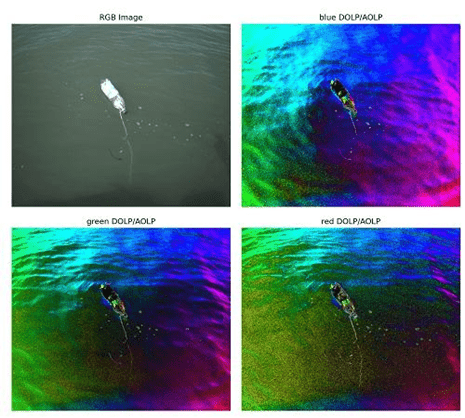
-
Exploration of Mineral Deposits: Hyperspectral imaging has found application in exploring mineral deposits, helping to identify and analyze the mineral compositions of soil and geological structures. Thanks to the ability to capture in a large number of narrow spectral bands, detailed information about the chemical composition of the soil and types of rock can be obtained. This allows geologists and researchers to more accurately determine the locations of valuable minerals, such as metals, minerals, or hydrocarbons, and plan resource exploitation more efficiently. This technology helps reduce time and financial costs for exploration and makes a significant contribution to sustainable development in the mining industry.
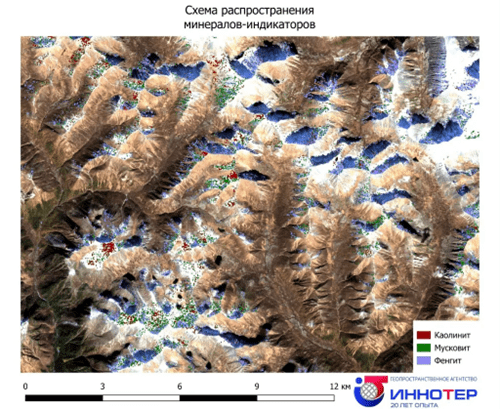
-
Agriculture: Hyperspectral imaging is applied in agriculture to optimize crop management and increase yields. By analyzing spectral data, the state of plants can be determined, stresses related to diseases or nutrient deficiencies can be identified, and measures can be taken to prevent them. This allows farmers to more accurately determine the need for irrigation, fertilization, and optimize the application of agricultural ingredients to increase crop yield and improve production efficiency.
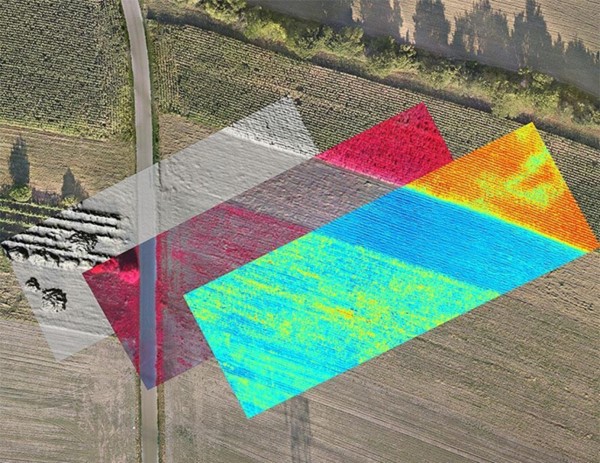
-
Hyperspectral imaging has significant applications in military surveillance. Due to its ability to record and analyze a wide spectrum of electromagnetic radiation, it can provide detailed images and classification of various objects and materials on land, in the air, or on water. This is useful for detecting hidden objects, identifying targets, analyzing the behavior and actions of the enemy, and assessing potential damage from military actions. Hyperspectral imaging helps expand the capabilities of military intelligence and provides valuable data for decision-making in national security.
